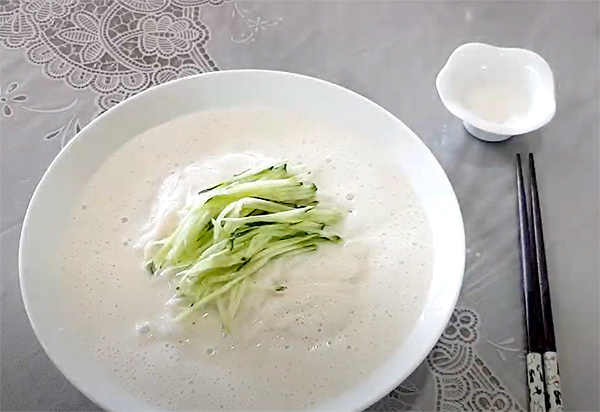Creamy and Rich Kongguksu (Korean Soybean Noodle Soup): A Step-by-Step Guide to Perfecting the Soybean Broth
Master the Art of Making Rich and Nutty Kongguksu at Home with Perfectly Boiled Meju Beans!

I personally adore the smooth and nutty soybean broth made from boiled meju beans. While it’s delicious on its own, serving it with freshly cooked somyeon noodles transforms it into an incredibly satisfying bowl of Kongguksu. This recipe will guide you through creating this delightful Korean summer classic.
Kongguksu Ingredients- 1 cup Meju beans (approx. 100g)
- 1/3 cucumber (for garnish)
- 1 serving Somyeon noodles (approx. 80-100g)
- Pinch of salt (to taste)
Cooking Instructions
Step 1
Begin by preparing the meju beans. Rinse 1 cup of meju beans thoroughly. Place them in a bowl, add enough water to fully submerge them, and soak for at least 8 hours or overnight. Soaking the beans ensures they become tender for smooth cooking and blending.

Step 2
Now, it’s time to boil the soaked meju beans. Pour ample water into a pot, enough to generously cover the beans, and bring it to a boil. As the water boils, a white foam will appear on the surface. From this point, continue to boil the beans for about 5 minutes until they are tender. Skimming off the floating bean skins and foam during boiling will make the peeling process easier later and help reduce any bean-like odor in the broth.

Step 3
Drain the boiled meju beans using a sieve and let them cool slightly. They should be cool enough to handle but still warm. Place the beans in a bowl filled with cold water. Gently rub and squeeze the beans with your hands to loosen and remove the skins. Be thorough in removing the skins for a smoother broth.

Step 4
Instead of putting the de-skinned beans directly into the blender, first reserve the bean-cooking water. Straining this water will be useful later. By adding some of this reserved cooking water to the blender when you grind the beans, you’ll enhance the nutty flavor and create a richer, more delicious soybean broth. This water is also helpful for adjusting the broth’s consistency.

Step 5
It’s time to use the blender! Add the de-skinned meju beans and some of the reserved bean-cooking water to the blender. Blend until very smooth. You can adjust the consistency of the broth by adding more or less of the cooking water; use less for a thicker broth and more for a thinner one. Ensure the beans are blended completely without any lumps for a silky texture.

Step 6
The next step for making Kongguksu is to cook the somyeon noodles. Bring a large pot of water to a rolling boil. Add the somyeon noodles, separating them to prevent sticking. Stir occasionally as they cook. Once the noodles are al dente, rinse them thoroughly under cold running water to remove excess starch and drain well.

Step 7
Behold, a beautifully creamy and rich soybean broth is ready! This broth is incredibly delicious simply sipped on its own. Enjoy it chilled as is, or add a bit of water or ice cubes for an even more refreshing experience.

Step 8
Place the cooked and drained somyeon noodles into a serving bowl. If the soybean broth seems too thick for your liking, add some of the reserved bean-cooking water or cold water to achieve your desired consistency. A few ice cubes can be added for extra coolness.

Step 9
Finally, garnish your Kongguksu with toppings for both visual appeal and added flavor. Thinly sliced cucumber or cherry tomatoes, or even a hard-boiled egg, make excellent additions. Even when your appetite is low, a bowl of homemade Kongguksu like this makes for a satisfying and delicious meal. Enjoy your culinary creation!




